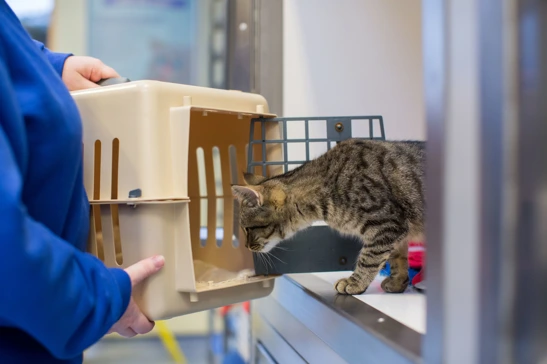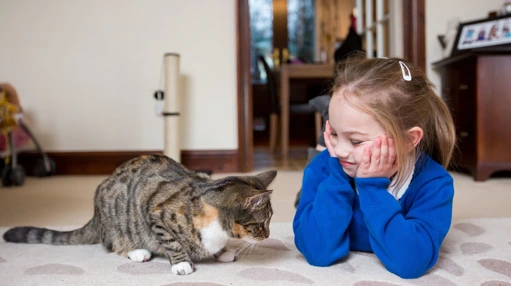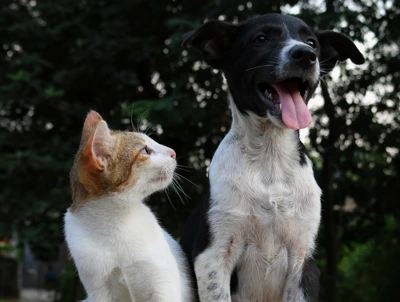Whether you’re adopting a kitten from Cats Protection or you’ve found one from a local breeder, bringing your new arrival home is an exciting experience. Kittens can be entertaining and playful – not to mention undeniably cute! Already thinking about the fun you’ll have? Now is the perfect time to prepare for a new kitten.
If you’ve bought a kitten online or from a local breeder, they’ll need to stay with their mum until they’re around eight to nine weeks old. You should have had a chance to meet your kitten already and take a look at their surroundings, ensuring that they are sociable, alert and have no visible health issues. If possible, you could ask to see the kitten's mother.
Your kitten should have also been ‘socialised’ properly before they come home with you, gradually exposing them to a number of experiences. This happens between two and eight weeks old and helps kittens to adjust to life while their brains and sensory systems are still developing. They should have experienced:
Watch our video on how to prepare for a kitten for helpful tips on preparing your home to be safe and comforting for a kitten.

Making kitten-related purchases is part of the fun, especially when it comes to choosing them new toys to play with. Before you begin buying novelty items and expensive treats, here’s a list of essential things your kitten will need before they arrive.

Before collecting your kitten, you’ll need to set up a designated space for them to settle in.
Remember to secure any areas in the room you don't want a kitten to enter – from cupboards to secret hiding holes. Pick a quiet area away from busier (and noisier) areas and make sure they have the following items nearby.
Once your home is set up for your cat, it’s time for the exciting part – taking them home! You’ll need a sturdy and well-ventilated cat carrier for bringing your kitten home in the car, which will need to be secured with a seatbelt once your kitten is inside.
Most kittens aren’t keen on being in a cat carrier, especially as their environment is new and strange to them. To keep them calm, consider placing a blanket or item from their home inside. Cats are heavily reliant on scent and will settle much quicker if their surroundings smell familiar.
How to choose and use a cat carrier
Watch our video on how to settle your kitten into its new home.
Once you’re home safely, it is time to gently introduce your kitten to their new environment. Give them the freedom to explore their new room, toys and items – no doubt giving them all a good sniff! If they choose to hide, sit quietly in the room and gently talk to them rather than forcing them out from their hiding space. It is completely natural for kittens to hide initially in a strange new environment.
For the first few days, limit them to just a couple of rooms initially so that they don’t feel overwhelmed. As they become more confident, you can introduce them to other areas of the house.

Once your kitten feels confident with you, you can gradually introduce other members of the family to them. While it is easy to get excited, it is important to remember to introduce people at your kitten’s pace – if they’re shy, it can be overwhelming for them to meet everyone at the same time.
Children are bound to be excited about the arrival of a new kitten. Before your little ones meet your kitten, prepare them by telling them to be gentle and calm. It is important that the kitten comes to them initially and they’re shown how to interact gently with them. Kittens also need a lot of sleep and will need to be left alone to rest, especially as they get used to their new home.
As your kitten becomes more comfortable, they’ll enjoy the playfulness of being around children. Naturally, kittens use their teeth and claws – making sure that you play with your kitten with appropriate toys instead of your hands and feet is important, particularly as their teeth and claws get bigger! Avoid using your fingers to encourage a cat in your direction too.
Find out more about cats and childrenWatch our video on how to introduce your cat to your family.

If you’ve already got a dog or other pet living in your home, you might be mindful of how they’ll get on with your new arrival. While cats and dogs are often thought of as enemies, it is often easier to introduce a cat to a dog than it is to introduce another cat – especially an inquisitive kitten!
As with all introductions, making sure the process is gradual is the key.
As kittens are smaller and generally more energetic than an adult cat, you’ll need to take extra care when introducing them to your dog – especially if your dog is easily excited.
To introduce them safely, you could use a stair gate to separate them from each other (after swapping scents with one another) before making a proper physical introduction. You could also think about introducing your dog to your kitten when they have already been out for a walk, when they are likely to be calmer.
Find out more about introducing dogs and other petsIf you already own a cat, introducing your kitten to your existing cat will need to be a careful process. While some cats enjoy the company of other cats, most are more than happy to live apart – in fact, it’s natural for cats to be territorial about their space. Older cats especially aren’t keen on having new kittens in their household, and this can result in a number of behavioural issues – from toileting in the house to hiding more.
Before you introduce your cats to each other, make sure that your kitten has their own bedding, food bowl and toys. Cats often don’t like to share, and this will help them to have space from each other. It is advised that you don't introduce your kitten and cat to each other straight away. Instead, help your kitten to get used to its space before being gradually introduced to your cat.
Find out more about introducing cats to other cats
If you know what your kitten has been eating in their previous home, it is advised to keep feeding them the same food at the same times. Familiar scents and tastes will help your cat to settle in gradually – and they’ll be more likely to eat what you’re providing them with!
If you’re unsure, you might feel overwhelmed at the numerous cat food brands at your local supermarket! Remember to choose food designed for cats, staying away from dog food or food intended for humans. Opt for a ‘complete’ food formulated specially for kittens. This will provide all the nutrients and minerals that your kitten needs for growing.
Kittens are energetic with small stomachs, so it is best to feed them little and often. When your kitten first arrives, aim to check their food and replace it four times a day – as well as providing plenty of fresh water. As they get older, you’ll get used to the amount that they eat and when. Cats older than six months should be fine if they’re fed twice a day while older cats may only need their food topping up once a day.
Find out more about what to feed your kittenWhile most young kittens may have learnt how to use a litter tray by the time they live with you, others need encouragement. To help train your kitten to use a litter tray, follow our top tips:

Is your kitten ready to go outside? Before you let them venture out to explore, you’ll need to make sure of the following:
When letting your kitten out for the first time, you’ll need to keep them company as they explore. Avoid picking them up and placing them outside - it is much better to let them make their own way out.
Planning their first trip out for a quiet period during the day is a good start and should help them to feel confident with the unfamiliar scents, sounds and smells of the outdoors. It is advised not to leave your kitten outside unsupervised until they are six months old. Try letting your kitten out before a meal - inquisitive kittens are much more likely to return if they're expecting food. Remember to keep the door or cat flap open to ensure they have the option to go outside or retreat back inside.
Once your kitten begins to feel confident going outside alone, you might want to think about using a cat flap – especially if you don’t fancy opening and closing the door for them all day! There are a number of cat flaps to choose from. Some are triggered by your cat’s microchip, only allowing entry for them, while others have in-built infrared systems. Of course, there are the traditional cat flaps too.
To teach your kitten to use the cat flap, try the following: